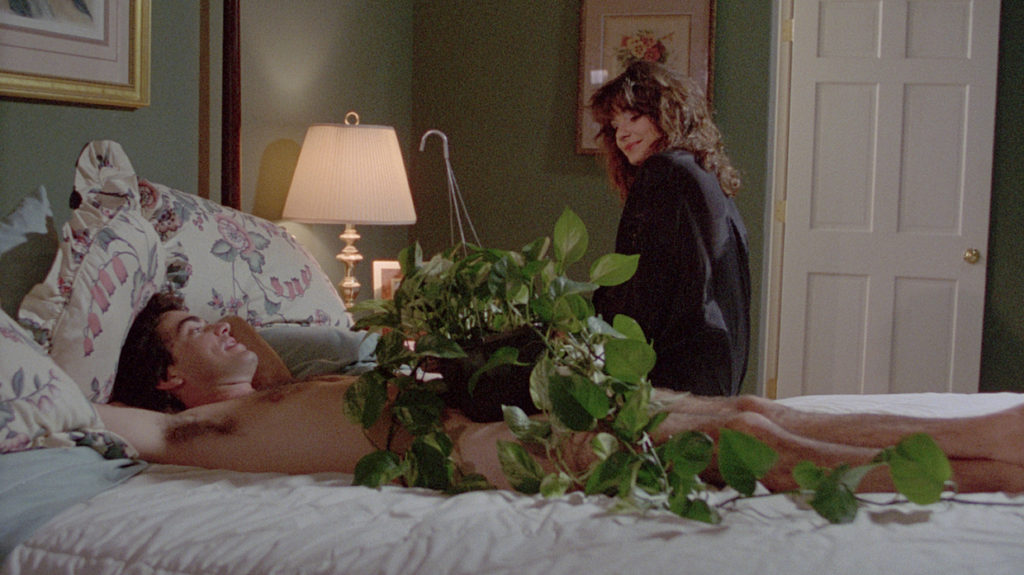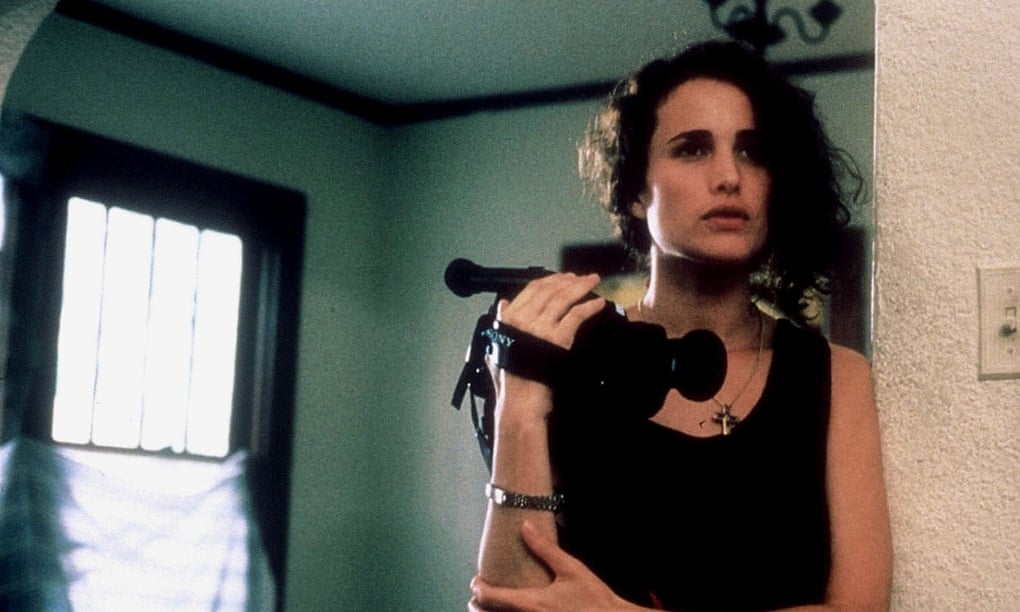Attend: Program Notes
sex, lies, and videotape | Steven Soderbergh | United States | 1989 | 100 min.
Cinesthesia, Madison Public Library Central Branch, Thursday, August 1, 6:30 p.m.
Thirty years after Steven Soderbergh’s provocative feature debut changed the face of American independent film, sex, lies, and videotape clearly resonates with the present era of internet porn, post-truth politics, and social networking.
Director Steven Soderbergh wrote the screenplay for sex, lies, and videotape in eight days, and on half of those he was driving from Baton Rouge to Los Angeles. It was a personal project and he did not know if anybody would even read it, let alone transform it into the breakout low-budget film that revolutionized American independent cinema. Soderbergh secured funding of $1.2 million from RCA/Columbia Home Video and the movie debuted at the U.S. Film Festival (soon to be renamed the Sundance Film Festival) within twelve and a half months after he first dropped the script on his agent’s desk. Although sex, lies, and videotape was unfinished, with temporary sound and titles made on a Xerox machine, the film won an audience prize. Soderbergh’s first narrative feature went on to win the Palme d’Or at the Cannes Film Festival and earned as much as $100 million worldwide on its initial theatrical release, which actually represents a return on investment proportionately higher than that of the same year’s megahit Batman. According to industry historian Peter Biskind, it was the “big bang of the modern indie film movement.”

In the director’s commentary recorded for the 1998 DVD release, Soderbergh recounts how some agents didn’t want to show the script to actors because they thought it was going to be a porn movie. Despite the sleazy tabloid connotations of the title, sex, lies, and videotape contains neither nudity nor explicit sexual activity. Rather, Soderbergh’s film confronts the naked realities of contemporary sexual politics with frank discourse and at times uncomfortable directness. His restless, intimate camera slowly tracks the four main characters as they talk to each other, deceive each other (and themselves), have or avoid sex with each other, and reveal the depths of their interior lives on videotape. While the subject matter is certainly provocative, the actual experience of watching the film may not be what one expects.
Shot on 35mm film, sex, lies, and videotape takes place in Baton Rouge, Louisiana, in summer. The film traces the shifting currents of desire that intertwine the complicated personal lives of four photogenic people in their early 30s. Ann (Andie MacDowell), a frustrated, prudish housewife, has entered long-term psychotherapy, worries about garbage flooding the world, and remains in denial about her sex life (or rather lack thereof). Unbeknownst to Ann, her husband, John (Peter Gallagher), an ambitious lawyer and inveterate philanderer, has been conducting a passionate affair with her promiscuous, emancipated sister, Cynthia (Laura San Giacomo). When John’s former college roommate, Graham (James Spader), walks into this tangled web, he inadvertently initiates a chain of events that will disrupt all of their lives.
Since John and Graham last saw one another nine years ago, Graham has become a long-haired, sexually ambivalent drifter who wears black shirts and lives in his car. A self-described recovering pathological liar, he now insists on being scrupulously honest and tends to ask fairly invasive questions point-blank. Ann finds herself attracted to the enigmatic stranger, although she refuses to acknowledge her feelings. She eventually discovers his peculiar private obsession and recoils in horror. Graham has a penchant for interviewing women about their sex lives on videotape and subsequently masturbating to the cassettes.

In a recent essay on the film titled “sex, lies, and videotape: Some Kind of Skin Flick,” critic Amy Taubin writes,
The brief account of the plot above does not do justice to the psychological complexity of the characters, the quicksilver dialogue, the play of desire and its repression, and the dramatization of how moving images had already, by 1989, begun to mediate all relationships—intimate, social, political, economic, you name it. We can see in sex, lies, and videotape the beginning of the way in which all our lives would become performances for our own cameras, and how performance, whether in the personal, social, or political sphere, cannot be trusted. Just as the lies that Reagan told on TV in 1986 during the Iran-Contra scandal led to the daily lies of the president who was elected in 2016, our need for personal technology to defend us from both our interiority and the outside world has become all-encompassing.
When sex, lies, and videotape was released in 1989, it truly captured the cultural zeitgeist, while offering a perspective on modern life and human sexuality that was practically nonexistent in American cinema.
Soderbergh observed, “What is ironic is that this is a culture obsessed with sex, but only up to a point. In the movies, for example, they’re more than willing to show a representation of the sex act, but I don’t think a lot of films want to deal with the real responsibilities and implications and repercussions of sex.”
“There are incredible emotions leading up to and following the physical act of sex. And that’s what I wanted to concern myself with; not with the act itself, which I think doesn’t vary that much for any one individual.” The director focuses on the fears and desires of men and women, the difference between sex and love, the destructiveness of lying, and the dangers of detachment as a lifestyle choice. In a way, sex, lies, and videotape turns the tables on the viewer by subverting expectations and presenting a raw portrayal of the complexities of human intimacy rather than the skin flick suggested by the movie’s title.

While sex, lies, and videotape definitely epitomizes its particular moment in time, the issues Soderbergh tackles are still very much alive today. Indeed, his film feels increasingly relevant as our relationship with technology becomes ever more similar to Graham’s.
At the time of the film’s release, Soderbergh explained to Film Comment why he used video as a metaphor for distance. “Video is a way of distancing ourselves from people and events. We tend to think that we can experience things because we watched them on tape. [Graham] needs the distance to feel free to react without anybody watching, which, I guess, is the definition of voyeurism….”
Soderbergh’s words call to mind those of Brian O’Blivion (played by Jack Creley) in David Cronenberg’s Videodrome (1983), an apocalyptic, mind-bending, techno-surrealist horror movie about how electronic media alters its users:
“The television screen is the retina of the mind’s eye. Therefore, the television screen is part of the physical structure of the brain. Therefore, whatever appears on the television screen emerges as raw experience for those who watch it. Therefore, television is reality, and reality is less than television.”
Through the lens of the twenty-first century, Soderbergh’s period piece may appear somewhat dated, but sex, lies, and videotape clearly resonates with the present era of internet porn, post-truth politics, and social networking. Graham’s problem has essentially become the modern mode of communication.

We rely on high-tech mobile devices to facilitate interpersonal connections, even as those same devices insulate each of us in our own hermetically sealed bubble of images and information. Our digital avatars grant us distance from people and events, while we freely gorge ourselves on a steady stream of stimuli.
The radiant, seductive, and artificial glow of intimacy generated by our ubiquitous screens represents a more socially acceptable and up-to-date form of the ersatz closeness Graham can only feel through the remove of a video recording. Look around you and, in truth, Graham might seem comparatively healthy.